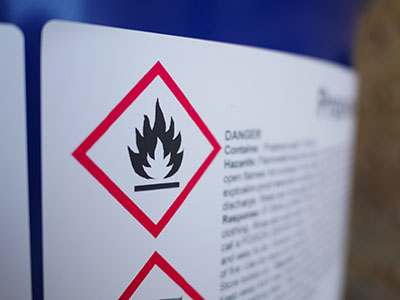 |
Hamadryas Baboons |
2.00 |
The only monkey species that lives in both Africa and Asia, hamadryas baboons make their homes on the faces of steep, craggy cliffs. These social monkeys fill their days with traveling, foraging, resting, and playing. Discover more in this course. |
 |
Hand and Power Tool Safety Awareness |
0.34 |
This course covers how to protect yourself and others around hand and power tools. Hand and power tools are powerful pieces of machinery that make difficult jobs such as landscaping easier. However, when hand and power tools are not safely used, they can be very dangerous and result in serious injury or death. Being knowledgeable of how to use power and hand tools will make you and your team more efficient and safe. |
 |
Hand Rearing Avian Neonates |
1.00 |
This webinar will be devoted to outlining general guidelines for hand rearing avian neonates. While some avian taxa have specialized needs, requiring specific techniques, procedure and protocols, there are many things that all avian neonates have in common. An overview of those needs and the criteria involved in creating and implementing these protocols will be highlighted. |
 |
Handline Operation #1101 (Instructor Guide) |
1.00 |
This is the Instructor Guide for Lesson #1101 Hoseline Operation. This training session is a skill demonstration and evolution. The presentation is an instructor lead discussion that reviews the importance of fire streamflow for structural firefighting. The lesson reviews standard GPM flows for the AHJ appliances and discusses appropriate situations for the use of those appliances. The training session is concluded with three skills stations that require firefighters to operate hoselines and fire streams from an exterior position. |
 |
Hands-On Math Learning Activities (CDA 2) |
2.00 |
Move beyond counting! This course unveils the exciting world of early math beyond simple number recognition. Witness engaging demonstrations of age-appropriate activities for infants, toddlers, and preschoolers, igniting their natural curiosity and love for mathematical concepts. Immerse yourself in the power of hands-on learning, the cornerstone of building strong foundational math skills in young minds. |
 |
Harassment and Discrimination Prevention |
1.00 |
A respectful workplace is a key element in creating a fair, collaborative, and inclusive environment that allows every member of a higher education institution’s community to meet their teaching, research, and public service goals. At the heart of a respectful workplace is zero tolerance for discrimination and harassment. |
 |
Hazard Communication Advanced |
1.00 |
This course covers an advanced level of hazard communication. Chemical hazards, in-depth analysis of chemical labels, as well as protection from chemical hazards are all covered in this course. |
 |
Hazard Communication Basic |
1.00 |
This course covers the basics when it comes to hazard communication. The topics will range from the Hazard Communication Standard to the labeling of hazardous materials. |
 |
Hazard Communication Basic (Short) |
0.25 |
This course covers the basics when it comes to hazard communication. The topics will range from the Hazard Communication Standard to the labeling of hazardous materials. |
 |
Hazardous Materials |
0.50 |
This course covers the basics of how to work with hazardous materials. You will learn how to work with combustible, flammable, and explosive materials, as well as the safety and training that goes along with it. |
 |
Hazardous Materials Spill Evolution #961 (Instructor Guide) |
1.00 |
This is the instructor guide for the Hazardous Materials Spill Evolution. This course will prepare the instructor to present and conduct this training session to an audience of firefighters. Course set-up requirements are described along with identification of key points and instruction for the demonstration and performance of the skill requirement of this training. |
 |
Head Trauma Interviews: Lesson 1 |
1.50 |
Lauren Wittman RN, BSN, CCRN-CMC, sits down to discuss some of the fundamental components of brain and skull Anatomy and Physiology with Jonathan J. Stone, M.D. . As the discussion continues, Dr. Stone offers an in-depth look at what we can expect when secondary trauma to the brain continues to manifest. This valuable information will assist you with understanding your local protocols no matter where you are. Final Exam: This multiple-choice exam is designed to test your knowledge of the material you just reviewed. You have two attempts to gain an 75% or higher on this exam. Please take your time and answer each question carefully. |
 |
Head Trauma Interviews: Lesson 2 |
2.00 |
In this second segment of our series, Christopher G. Zammit, M.D. sits down with Lauren Wittman, RN, BSN, CCRN-CMC and they define what head trauma is and how best to treat it. Final Exam: This multiple-choice exam is designed to test your knowledge of the material you just reviewed. You have two attempts to gain an 75% or higher on this exam. Please take your time and answer each question carefully.
|
 |
Health and Safety in the Laboratory |
0.75 |
This course is designed for employees who work in a laboratory setting. It covers the health and safety measures that should be taken in the lab and how to best protect yourself from hazardous exposures. |
 |
Health and Stress Management for Paraprofessionals |
1.00 |
Every day, paraprofessionals dedicate themselves to caring for and nurturing students and families. Often, paraprofessionals are so dedicated to serving others, they neglect their own needs. When this happens, paraprofessionals can experience stress that causes them to become overwhelmed, exhausted, frustrated, dissatisfied with job responsibilities, and unappreciated. When they maintain a healthy, balanced lifestyle, paraprofessionals are in a much better position to face the challenges of supporting and nurturing children and families with positive energy, enthusiasm, patience, and empathy.
By developing self-awareness, linking their personal and professional goals, developing a healthy balanced lifestyle, and identifying and managing stressors effectively, they can create and maintain a positive sense of well-being that allows them to maximize their ability to build positive relationships with students, parents, colleagues, and others. |
 |
Health and Stress Management for Teachers |
1.00 |
Every day, teachers dedicate themselves to caring for and nurturing students and families. Often, teachers are so dedicated to serving others, they neglect their own needs. When this happens, teachers can experience stress that causes them to become overwhelmed, exhausted, frustrated, dissatisfied with job responsibilities, and unappreciated. When they maintain a healthy, balanced lifestyle, teachers are in a much better position to face the challenges of supporting and nurturing children and families with positive energy, enthusiasm, patience, and empathy.
By developing self-awareness, linking their personal and professional goals, developing a healthy balanced lifestyle, and identifying and managing stressors effectively, they can create and maintain a positive sense of well-being that allows them to maximize their ability to build positive relationships with students, parents, colleagues, and others. |
 |
Healthy Bodies: Promoting Good Nutrition and Physical Activity in Child Care |
1.00 |
This course will give you a broad overview of how to instill healthy habits at an early age. It will provide you with information about the nutritional needs of children and the benefits and risks associated with physical activity levels. Strategies will be given to use this knowledge in the classroom. |
 |
Heat Illness |
0.75 |
This course covers the basics when it comes to heat-related illnesses. The topics discussed will include warning signs, types of heat-related illnesses, and how to prevent these illnesses. |
 |
Helping Children with ADD Succeed in School-Age Programs |
2.00 |
Children with ADD regularly experience struggles and challenges at home, in school, and in the community. Without the help of knowledgeable, understanding, and supportive people, they often experience multiple failures and frustrations on a daily basis. Typically, they lack the self-confidence that stems from learning how to do things well. Their lack of social skills and self-control makes it hard for them to make friends with schoolmates and children they meet in program activities. By the school-age years, many of these children do not feel good about themselves. They feel lonely and ostracized. Their self-esteem sinks a little lower every day.
Staff in school-age programs are in a position to make a positive difference in the lives of children with ADD. Armed with important information and management tools, they can help reverse the cycle of failure and frustration that results in low self-esteem in these children. They can make life easier, happier, and more satisfying for children with ADD, their parents, other children in the program, and themselves.
IMPORTANT NOTE: ADD stands for Attention Deficit disorder. Many professionals refer to this disorder as ADHD, which stands for Attention Deficit Hyperactivity Disorder. Some professionals use these terms simultaneously or interchangeably. In this module, the term ADD is used to refer to the basic form of the disorder and recognizes that the basic pattern of inattention associated with ADD often includes the component of hyperactivity related to extremes in temperament. |
 |
Helping Children with ADD Succeed In School-Age Programs (Collection) |
2.00 |
Children with ADD regularly experience struggles and challenges at home, in school, and in the community. Without the help of knowledgeable, understanding, and supportive people, they often experience multiple failures and frustrations on a daily basis. Typically, they lack the self-confidence that stems from learning how to do things well. Their lack of social skills and self-control makes it hard for them to make friends with schoolmates and children they meet in program activities. By the school-age years, many of these children do not feel good about themselves. They feel lonely and ostracized. Their self-esteem sinks a little lower every day.
Staff in school-age programs are in a position to make a positive difference in the lives of children with ADD. Armed with important information and management tools, they can help reverse the cycle of failure and frustration that results in low self-esteem in these children. They can make life easier, happier, and more satisfying for children with ADD, their parents, other children in the program, and themselves.
IMPORTANT NOTE: ADD stands for Attention Deficit disorder. Many professionals refer to this disorder as ADHD, which stands for Attention Deficit Hyperactivity Disorder. Some professionals use these terms simultaneously or interchangeably. In this module, the term ADD is used to refer to the basic form of the disorder and recognizes that the basic pattern of inattention associated with ADD often includes the component of hyperactivity related to extremes in temperament. |
 |
Helping Children with ADD Succeed In School-Age Programs: Characteristics and Needs of Children |
1.00 |
Children with ADD regularly experience struggles and challenges at home, in school, and in the community. Without the help of knowledgeable, understanding, and supportive people, they often experience multiple failures and frustrations on a daily basis. In this course, we will explore characteristics and needs of children with ADD. |
 |
Helping Children with ADD Succeed In School-Age Programs: Strategies and Techniques for Staff |
1.00 |
Children with ADD regularly experience struggles and challenges at home, in school, and in the community. Without the help of knowledgeable, understanding, and supportive people, they often experience multiple failures and frustrations on a daily basis. In this course, we will examine strategies and techniques that staff can use when working with children with ADD. |
 |
Helping Students with ADD Succeed for Paraprofessionals |
1.50 |
Children with Attention Deficit Disorder (ADD) regularly experience struggles and challenges at home, in school, and in the community. Paraprofessionals are in a unique position to make a positive difference in the lives of students with ADD. Armed with important information and management tools, they can help reverse the cycle of failure and frustration that results in low self-esteem in these students. They can make life easier, happier, and more satisfying for students with ADD, their parents, other children in the class, and themselves. |
 |
HEPA Standards 2.0 and the Self-Assessment Tool |
1.00 |
In 2011 the National AfterSchool Association adopted standards for healthy eating and physical activity (HEPA) in out-of-school time. In 2018, the HEPA Standards were updated to Version 2.0.
This interactive e-learning course, commissioned by the Kentucky Out-of-School Alliance (KYOSA) and designed by CypherWorx, will explain how the HEPA Standards were created and how they should be used, as well as presenting the Standards in their entirety. We will also cover the HEPA Standards 2.0 Self-Assessment Tool and how to use it. |
 |
Herramientas Fundamentales para Monitorear el Desarrollo Infantil (CDA 7) (Spanish) Fundamental Tools to Monitor Child Development (CDA 7) |
2.00 |
Este curso sumerge a los profesionales de la educación y el cuidado infantil en el poderoso trío de observación, documentación y evaluación. Descubra cómo estas herramientas le permiten monitorear de cerca el progreso de cada niño, identificar necesidades e intereses individuales y adaptar el apoyo en consecuencia. Profundice en el uso de actividades de evaluación para perfeccionar y elevar la calidad de la atención preescolar, garantizando que cada niño alcance su máximo potencial.
This course immerses early care and education professionals in the powerful trio of observation, documentation, and assessment. Discover how these tools allow you to closely monitor each child's progress, identify individual needs and interests, and tailor support accordingly. Dive deeper into using assessment activities to refine and elevate the quality of preschool care, ensuring every child reaches their full potential. |


























